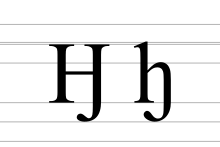Heng (letter)
| Heng | |
|---|---|
| Ꜧ ꜧ | |
 | |
 | |
| Usage | |
| Writing system | Latin script |
| Type | Alphabetic |
| Language of origin | Unified Northern Alphabet |
| History | |
| Development |
|
| Other | |
Heng is a letter of the Latin alphabet, originating as a typographic ligature of h and ŋ. It is used for a voiceless y-like sound[clarification needed], such as in Dania transcription of the Danish language.
Heng was used word-finally in early transcriptions of Mayan languages, where it may have represented a uvular fricative.
It is sometimes used to write Judeo-Tat. [citation needed]
Heng has been occasionally used by phonologists to represent a jocular phoneme in English, which includes both [h] and [ŋ] as its allophones, to illustrate the limited usefulness of minimal pairs to distinguish phonemes. /h/ and /ŋ/ are separate phonemes in English, even though no minimal pair for them exists due to their complementary distribution.[1]
Heng is also used in Bantu linguistics to indicate a voiced alveolar lateral fricative ([ɮ]).[2]
Both U+A726 Ꜧ LATIN CAPITAL LETTER HENG and U+A727 ꜧ LATIN SMALL LETTER HENG are encoded in Unicode block Latin Extended-D; they were added with Unicode version 5.1 in April 2008.
Transcription
[edit]A variant form, U+0267 ɧ LATIN SMALL LETTER HENG WITH HOOK, is encoded as part of the IPA Extensions Block. It is used to represent the voiceless palatal-velar fricative in the International Phonetic Alphabet. U+10797 𐞗 MODIFIER LETTER SMALL HENG WITH HOOK is used as a superscript IPA letter[3]
Teuthonista
[edit]The Teuthonista phonetic transcription system uses both heng and U+AB5C ꭜ MODIFIER LETTER SMALL HENG.[4]
See also
[edit]References
[edit]- ^ Hornsby, David (2014). Linguistics: A Complete Introduction: Teach Yourself. John Murray Press. ISBN 9781444180343.
- ^ Wells, John (3 November 2006). "The symbol ɮ". John Wells’s phonetic blog. Department of Phonetics and Linguistics, University College London. Retrieved 1 February 2018.
- ^ Miller, Kirk; Ashby, Michael (2020-11-08). "L2/20-252R: Unicode request for IPA modifier-letters (a), pulmonic" (PDF).
- ^ Everson, Michael; Dicklberger, Alois; Pentzlin, Karl; Wandl-Vogt, Eveline (2011-06-02). "L2/11-202: Revised proposal to encode "Teuthonista" phonetic characters in the UCS" (PDF).
- Chao, Yuen Ren (1934). "The non-uniqueness of phonemic solutions of phonetic systems". Bulletin of the Institute of History and Philology, Academia Sinica. 4 (4): 363–397.
- Pullum, Geoffrey K.; Ladusaw, William A. (1996). Phonetic Symbol Guide. University of Chicago Press. p. 77.
| Alphabets (list) | |||||||||||||||||||||||||||||||||||||||||||||||||||||||||||||||||||||||||||||||||||||||||||||||||||||||||||||||||||||||||||||||||||||||||||||||||||||||||||||||||||||||||||||||||||||||||||||||||||||||||||||||||||||||||||||||||||||||||||
|---|---|---|---|---|---|---|---|---|---|---|---|---|---|---|---|---|---|---|---|---|---|---|---|---|---|---|---|---|---|---|---|---|---|---|---|---|---|---|---|---|---|---|---|---|---|---|---|---|---|---|---|---|---|---|---|---|---|---|---|---|---|---|---|---|---|---|---|---|---|---|---|---|---|---|---|---|---|---|---|---|---|---|---|---|---|---|---|---|---|---|---|---|---|---|---|---|---|---|---|---|---|---|---|---|---|---|---|---|---|---|---|---|---|---|---|---|---|---|---|---|---|---|---|---|---|---|---|---|---|---|---|---|---|---|---|---|---|---|---|---|---|---|---|---|---|---|---|---|---|---|---|---|---|---|---|---|---|---|---|---|---|---|---|---|---|---|---|---|---|---|---|---|---|---|---|---|---|---|---|---|---|---|---|---|---|---|---|---|---|---|---|---|---|---|---|---|---|---|---|---|---|---|---|---|---|---|---|---|---|---|---|---|---|---|---|---|---|---|---|---|---|---|---|---|---|---|---|---|---|---|---|---|---|---|---|
| Letters (list) |
| ||||||||||||||||||||||||||||||||||||||||||||||||||||||||||||||||||||||||||||||||||||||||||||||||||||||||||||||||||||||||||||||||||||||||||||||||||||||||||||||||||||||||||||||||||||||||||||||||||||||||||||||||||||||||||||||||||||||||||
| Multigraphs |
| ||||||||||||||||||||||||||||||||||||||||||||||||||||||||||||||||||||||||||||||||||||||||||||||||||||||||||||||||||||||||||||||||||||||||||||||||||||||||||||||||||||||||||||||||||||||||||||||||||||||||||||||||||||||||||||||||||||||||||
| Keyboard layouts (list) | |||||||||||||||||||||||||||||||||||||||||||||||||||||||||||||||||||||||||||||||||||||||||||||||||||||||||||||||||||||||||||||||||||||||||||||||||||||||||||||||||||||||||||||||||||||||||||||||||||||||||||||||||||||||||||||||||||||||||||
| Standards | |||||||||||||||||||||||||||||||||||||||||||||||||||||||||||||||||||||||||||||||||||||||||||||||||||||||||||||||||||||||||||||||||||||||||||||||||||||||||||||||||||||||||||||||||||||||||||||||||||||||||||||||||||||||||||||||||||||||||||
| Lists | |||||||||||||||||||||||||||||||||||||||||||||||||||||||||||||||||||||||||||||||||||||||||||||||||||||||||||||||||||||||||||||||||||||||||||||||||||||||||||||||||||||||||||||||||||||||||||||||||||||||||||||||||||||||||||||||||||||||||||
Text is available under the CC BY-SA 4.0 license; additional terms may apply.
Images, videos and audio are available under their respective licenses.
